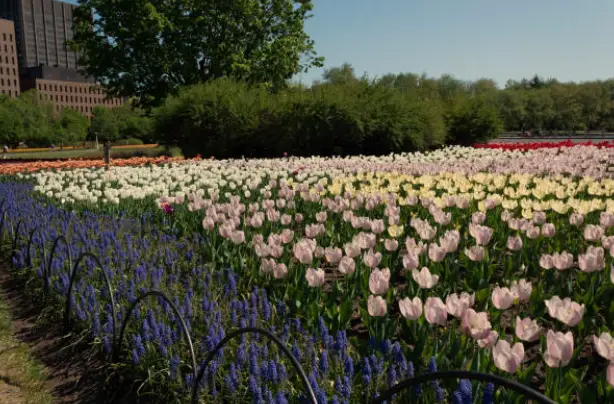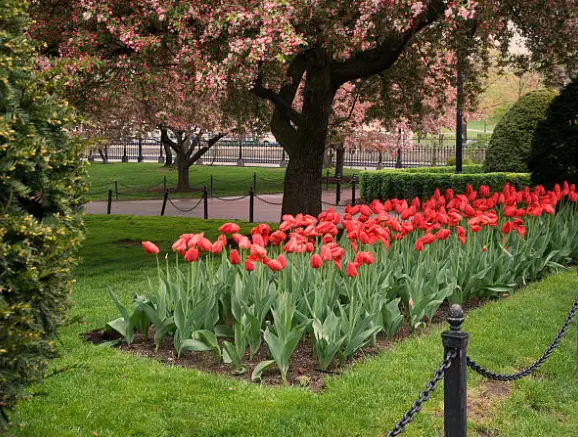If you’re a gardener in the St. Louis area, paying close attention to hardiness zones is crucial for ensuring your plants thrive. The USDA Plant Hardiness Zone Map divides North America into zones based on the average annual minimum winter temperature. Knowing which zone you’re in helps determine which plants are most likely to survive and perform well in your local climate.
St. Louis’s Growing Zone
So what growing zone is St. Louis? The city itself lies in Zone 6b, according to the 2012 USDA Plant Hardiness Zone Map. This zone is defined as experiencing average annual extreme minimum temperatures between -5°F and 0°F (-20.6°C and -17.8°C).

Growing Zone St. Louis
However, it’s important to note that microclimates can exist even within a relatively small geographic area like the St. Louis metro region. Wind patterns, elevation changes, heat absorption and radiation from buildings and pavement can all contribute to “heat islands” that are slightly warmer than the official zone designation. Some areas could realistically be solidly in Zone 7a, with average extreme minimums ranging from 0°F to 5°F (-17.8°C to -15°C).
Additionally, many of the surrounding suburbs and rural expanses may fall into slightly cooler Zone 6a, with extreme minimums between -10°F and -5°F (-23.3°C and -20.6°C). So while 6b is a good general guide for St. Louis proper, it’s wise for gardeners to observe the winter conditions in their specific neighborhood or backyard over a few seasons to more precisely determine the appropriate hardiness zone.
Picking Plants for Zone 6
Armed with the knowledge that St. Louis falls into the Zone 6 range, you can start selecting plants that are rated for that zone or lower. Plants listed as “Zone 6 hardy” should be able to withstand the typical winter cold. Those listed as “Zone 7” or higher are technically considered marginally hardy or non-hardy for the area and may need extra protection like mulch, sheltered locations, or brought indoors during winter.
When browsing plant tags, catalogs or descriptions, you’ll often see a range like “Zones 5–9.” This means the plant should survive anywhere between the extreme minimums of Zone 5 (as cold as -20°F/-28.9°C) up to the Zone 9 range (as warm as 20°F/-6.7°C). For St. Louis Zone 6 conditions, this plant would do just fine.
Annuals and warm-season Season Plants
One important distinction is that the hardiness zones specifically refer to cold tolerance for perennial plants—trees, shrubs, and flowers—that go dormant in winter but persist year-to-year. For annual plants like vegetables that get planted anew each spring, these maps don’t directly apply.

Growing Zone St. Louis
However, annuals do have temperature preferences and limits, so the zone information is still useful as a general guideline. Cool-season annuals like lettuce, spinach, broccoli and peas can be planted about a month before the last expected frost date in spring. Whereas warm-season crops like tomatoes, peppers, and melons should go out a few weeks after the last expected spring frost.
St. Louis’s last expected spring frost date based on 30-year averages is around April 10th, with the first expected autumn freeze around October 20th. This knowledge of approximate frost dates combined with the zone information gives a good estimated range for when to start and finish the growing season for different types of plants.
Microclimates in the Garden
Just as areas within the broader St. Louis region may vary somewhat from the 6b designation, microclimates also exist right in your own yard and garden space. The orientation, drainage, wind exposure and heat absorption of a given garden bed or section can create areas that are slightly cooler or warmer than others.
For example, a garden area near a south-facing fence or brick wall may stay a few degrees warmer in winter and be better suited to marginally hardy plants compared to an exposed north-facing bed. Low spots where cold air drains and settles will be cooler zones than raised beds with better airflow. Understanding these microclimatic influences allows you to site plants in the optimal positions for their needs in your landscape.
Adjusting Practices for Hardiness
Beyond plant selection, gardeners can adjust their practices to help protect plants from Zone 6 winter damage. Applying winter mulch like straw, bark chips or leaves around the bases of trees, shrubs and perennials provides an insulating layer over the roots. This prevents the soil from freezing and thawing as dramatically, avoiding potential damage.
You can also wrap or burlap screening around upright shrubs and small trees to guard against desiccating winter winds and sunscald on the bark. Covering plants with polyspun frost blankets can provide a few degrees of warmth when extreme cold snaps are forecast.
For potted plants, you may need to move containers into an unheated garage or shed to reduce the risk of roots freezing solid in the pots. Keeping them from exposure to direct winter winds is also advisable for container specimens.
When planting in fall, it’s best to give new additions at least 6 weeks of pre-winter root development to help them become established before going dormant. Holding off on major pruning until late winter or early spring can prevent pruning wounds that are slow to heal and subject to cold damage.
Cold Frame Season Extension
Handy St. Louis gardeners can extend the growing season by constructing cold frames—simple, unheated enclosures that create a microclimate of several zones warmer than the surroundings. The transparent lid lets in light and heat from the sun while providing protection from extreme cold.
During winter, a cold frame with additional insulation can keep leafy greens, herbs and cool-season veggies going weeks longer than the open garden. In spring and fall, it provides an earlier start and later harvest for warm-season crops without heat. Watered properly, a cold frame can essentially allow for Zone 7 or 8 growing conditions, even in a Zone 6 climate.
The Importance of Acclimatization
No matter what zone you’re in, acclimatizing plants for the transition between seasons is critical. Don’t rush warm-season plants out too soon in spring, as a lingering overnight freeze can kill growth that has become accustomed to warmer temperatures.
Similarly, don’t leave Zone 7 and higher perennials, trees and shrubs exposed to the first hard freezes of fall before they can begin their cold acclimation process. Frosts and freezes on non-hardened growth are often what leads to winter kill on marginally hardy plants.
Embracing the St. Louis Zone 6 Climate
While it would be nice to grow tropical plants year-round outdoors in St. Louis, the Zone 6b ranking is part of what gives the region’s gardens such vibrant variety through the seasons. With a wide assortment of heat-tolerant but cold-hardy cultivars to choose from, you can create attractive and productive gardens from early spring bulbs through asters blooming after first frost.
Learning to work within your plant hardiness zone is the secret to growing success year after year. With some adjustments to planting schedules, protection practices, and well-researched plant selections, St. Louis gardeners can revel in the bounty of flowers, fruits and vegetables tailor-made for the area’s transitional continental climate. Embrace the Zone 6 experience!




